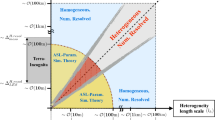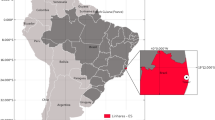Abstract
The temporal spectral response of a coupled land-atmosphere system to daily forcing of net radiation at the land surface is investigated using the analytic approach. The original definition of the problem dates back to an early study by Lettau. The present study builds on the problem and introduces some important additions, with a focus on the propagation of heat flux and temperature waves in both the soil and the atmospheric boundary layer. The study highlights the dependence of the complex amplitude of surface temperature and heat fluxes on the different land-surface parameters, such as friction velocity, evaporative fraction, aerodynamic resistance and vegetation height. Finally, the dependency of surface state variables to the frequency of the forcing is analyzed.
Similar content being viewed by others
Abbreviations
- λ:
-
Latent heat of vaporisation at the triple point (2.45 × 106 J kg−1)
- λ G :
-
Penetration depth of the soil heat wave (m)
- λ H :
-
Penetration depth of the sensible heat flux wave (m)
- λ s :
-
Soil thermal conductivity (W m−1K−1)
- λ θ :
-
Penetration depth of the potential temperature wave (m)
- λ E(z):
-
Latent heat flux at height z (W m−2)
- λ E(h):
-
Latent heat flux at the canopy height h (W m−2)
- ω :
-
Angular frequency of the harmonic (rad s−1)
- ρ :
-
Surface air density (1.2 kg m−3)
- θ :
-
Mean potential temperature in the boundary layer (K)
- E F :
-
Evaporative fraction at the land surface (nominal value is 0.6)
- C s :
-
Soil heat capacity (nominal value is 1.42 × 106 J m−3K−1)
- C p :
-
Specific heat capacity of the air at constant pressure (1012 J kg−1 K−1)
- d :
-
Zero-plane displacement (m)
- G :
-
Ground heat flux (W m−2)
- h :
-
Vegetation height (nominal value is 0.5m)
- H :
-
Turbulent (sensible) heat flux of potential temperature \({\overline{{w}'{\theta }'}}\) (Kms−1)
- K s :
-
Soil thermal diffusivity (nominal value is 2.5 × 10−7 m2 s−1)
- k :
-
Von karman’s constant (0.4)
- \({r_{a}^{c}}\) :
-
Canopy aerodynamic resistance (nominal value is 50 s m−1)
- R n :
-
Net radiation at the land surface (nominal peak value is 500W m−2)
- T deep :
-
Deep soil temperature (K)
- T s :
-
Soil temperature (K)
- T surf :
-
Soil surface temperature (K)
- T day :
-
Duration of a day (s)
- u * :
-
Friction velocity at the land surface (nominal value is 0.2m s−1)
- z 1 :
-
Measurement height (nominal value is 2m)
- z i :
-
Boundary-layer height (m)
References
Brutsaert WH (1982) Evaporation into the atmosphere. Kluwer Academic Publishers, Dordrecht, Holland, p 299 pp
Carslaw HS, Jaeger JC (1967) Conduction of heat in solids. Oxford University Press, New York, p 353 pp
Chehbouni A, Escadafal R, Duchemin B, Boulet G, Simonneaux V, Dedieu G, Mougenot B, Khabba S, Kharrou MH, Maisongrande P, Merlin O, Chaponnière A, Ezzahar J, Er-Raki S, Hoedjes J, Hadria R, Abourida A, Cheggour A, Raibi F, Boudhar A, Benhadj I, Hanich L, Benkaddour A, Guemouria N, Chebouni AH, Lahrouni A, Olioso A, Jacob F, Williams DG, Sobrino J (2008) An integrated modelling and remote sensing approach for hydrological study in arid and semi-arid regions: the SUDMED Program. Int J Remote Sens 29: 5161–5181
Choudhury BJ, Monteith JL (1988) A four-layer model for the heat budget of homogeneous land surfaces. Q J Roy Meteorol Soc 114: 373–398
Crago R (1996) Conservation and variability of the evaporative fraction during the daytime. J Hydrol 180: 173–194
Crago R, Brutsaert W (1996) Daytime evaporation and the self-preservation of the evaporative fraction and the Bowen ratio. J Hydrol 178: 241–255
Crank J (1956) The mathematics of diffusion. Oxford University Press, New York, p 356 pp
Duchemin B et al (2006) Monitoring wheat phenology and irrigations in Central Morocco: On the use of relationships between evapotranspiration, crops coefficients, leaf area index and remotely-sensed vegetation indices. Agr Water Manage 79: 1–27
Garratt JR (1992) The atmospheric boundary layer. Cambridge University Press, Cambridge, UK, p 316 pp
Gentine P, Entekhabi D et al (2007) Analysis of evaporative fraction diurnal behaviour. Agric For Meteorol 143: 13–29
Holtslag AAM, Moeng CH (1991) Eddy diffusivity and countergradient transport in the convective atmospheric boundary layer. J Atmos Sci 48: 1690–1698
Karam MA (2000) A thermal wave approach for heat transfer in a nonuniform soil. Soil Sci Soc Am J 64: 1219–1225
Kimura F, Shimizu Y (1994) Estimation of sensible and latent heat fluxes from soil surface temperature using a linear air-land heat transfer model. J Appl Meteorol 33: 477–489
Lettau H (1949) Isotropic and non-isotropic turbulence in the atmospheric surface layer. Geophys Res Lett 1: 13–84
Lettau H (1951) Theory of surface temperature and heat-transfer oscillations near level ground surface. EOS 32: 189–200
Lhomme J-P, Elguero E (1999) Examination of evaporative fraction diurnal behaviour using a soil-vegetation model coupled with a mixed-layer model. Hydrol Earth Syst Sci 3: 259–270
Monteith JL (1973) Principles of environmental physics. Edward Arnold, London, UK, p 241 pp
Nichols WE, Cuenca RH (1993) Evaluation of the evaporative fraction for parameterization of the surface energy-balance. Water Resour Res 29: 3681–3690
Plate EJ (1971) Aerodynamic characteristics of atmospheric boundary layers. US Atomic Energy Commission Division of Technical Information, Oak Ridge, TN, 190 pp
Shuttleworth WJ, Gurney RJ, Hsu AY, Ormsby JP (1989) FIFE: the variation in energy partition at surface flux sites. IAHS Publ 186: 67–74
Stevens B (2000) Quasi-steady analysis of a PBL model with an Eddy-diffusivity profile and nonlocal fluxes. Mon Weather Rev 128: 824–836
Thom AS, Stewart JB, Oliver HR, Gash JHC (1975) Comparison of aerodynamic and energy budget estimates of fluxes over a pine forest. Q J Roy Meteorol Soc 101: 93–105
Van De Wiel BJH, Moene AF, Ronda RJ, Bruin HAR, Holtslag AAM (2007) Intermittent turbulence and oscillations in the stable boundary layer over land part II: a system dynamics approach. J Atmos Sci 59: 2567–2581
Van Dop H, Verver G (2001) Countergradient transport revisited. J Atmos Sci 58: 2240–2247
Zilitinkevich S, Gryanick VM, Lykossov VN, Mironov DV (1999) Third-order transport and nonlocal turbulence closures for convective boundary layers. J Atmos Sci 56: 3463–3477
Author information
Authors and Affiliations
Corresponding author
Rights and permissions
About this article
Cite this article
Gentine, P., Entekhabi, D. & Polcher, J. Spectral Behaviour of a Coupled Land-Surface and Boundary-Layer System. Boundary-Layer Meteorol 134, 157–180 (2010). https://doi.org/10.1007/s10546-009-9433-z
Received:
Accepted:
Published:
Issue Date:
DOI: https://doi.org/10.1007/s10546-009-9433-z




